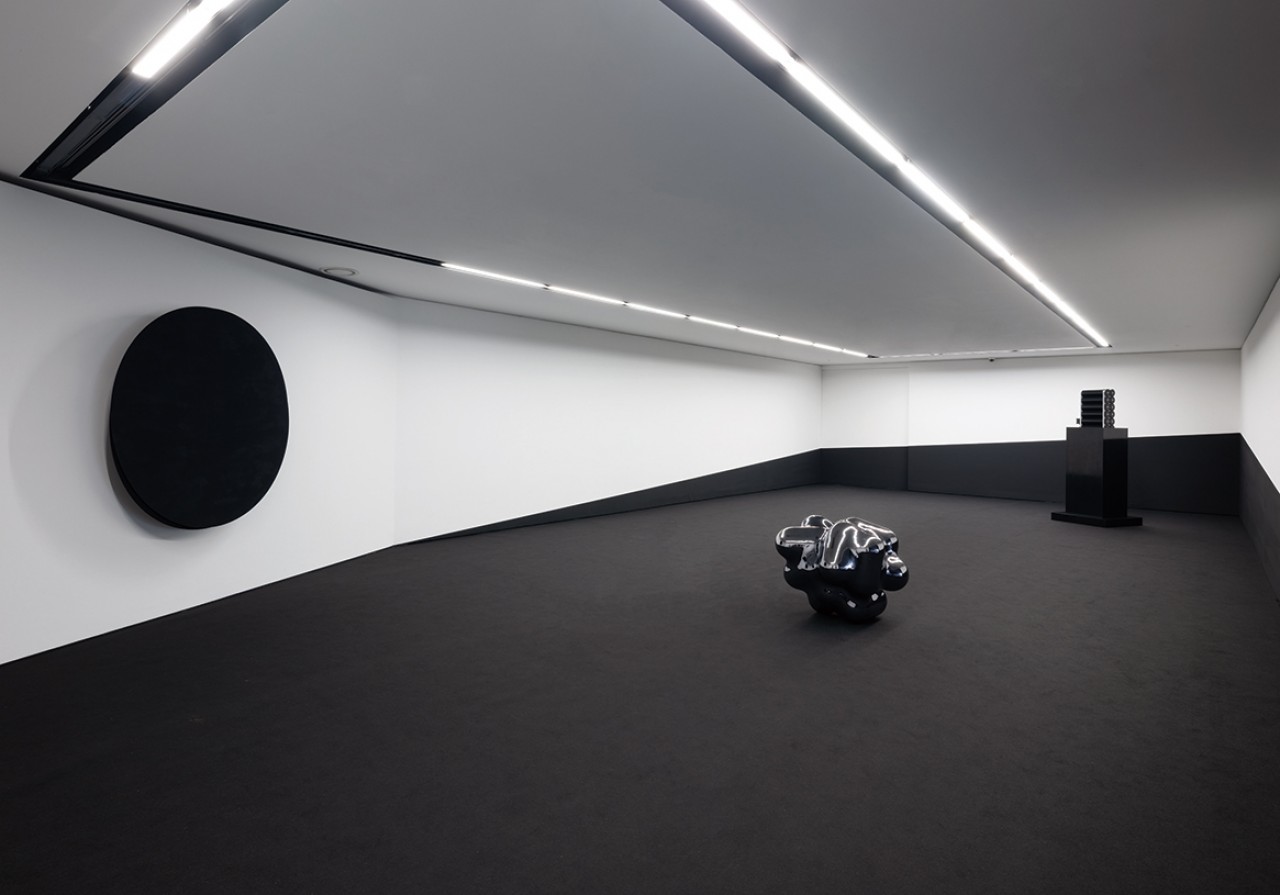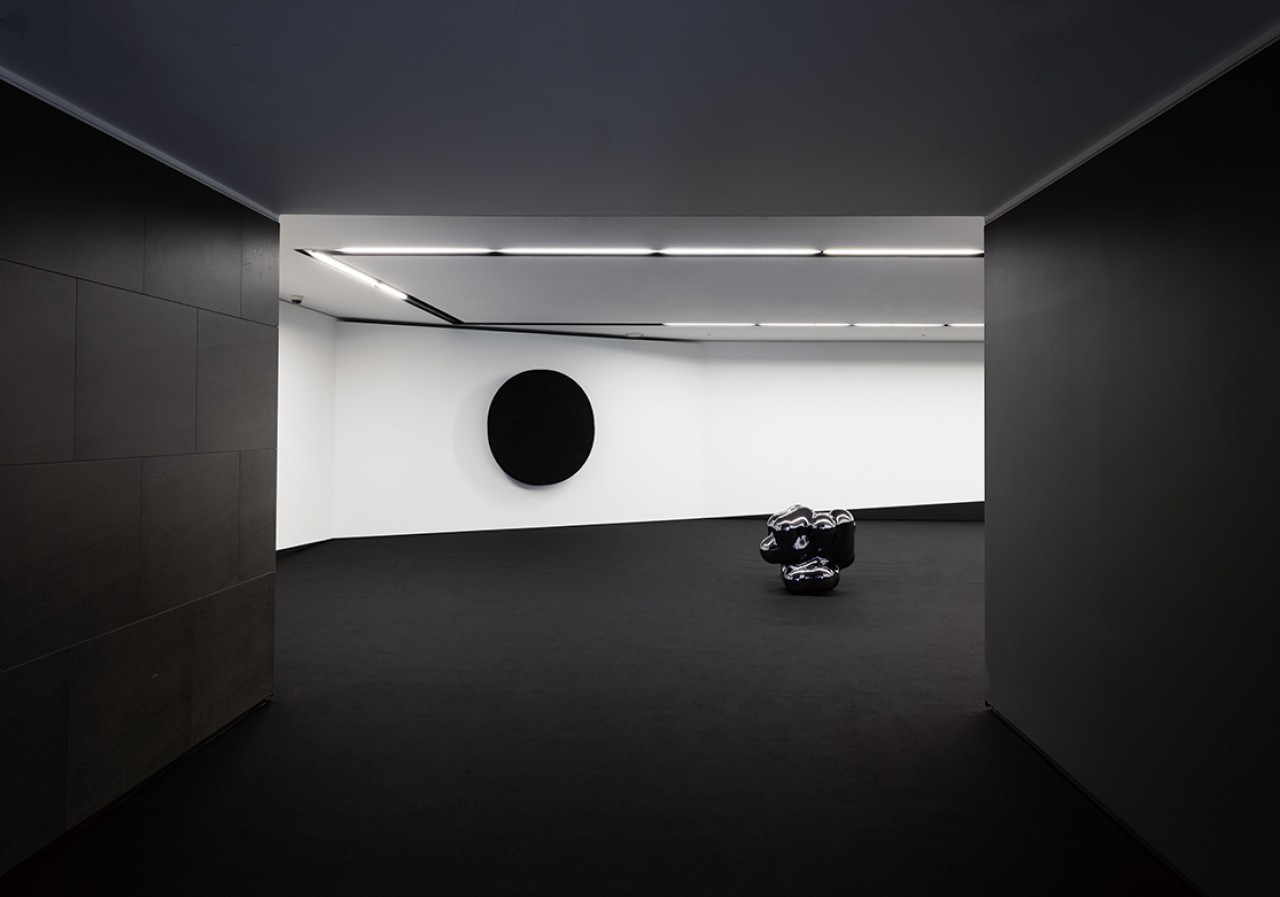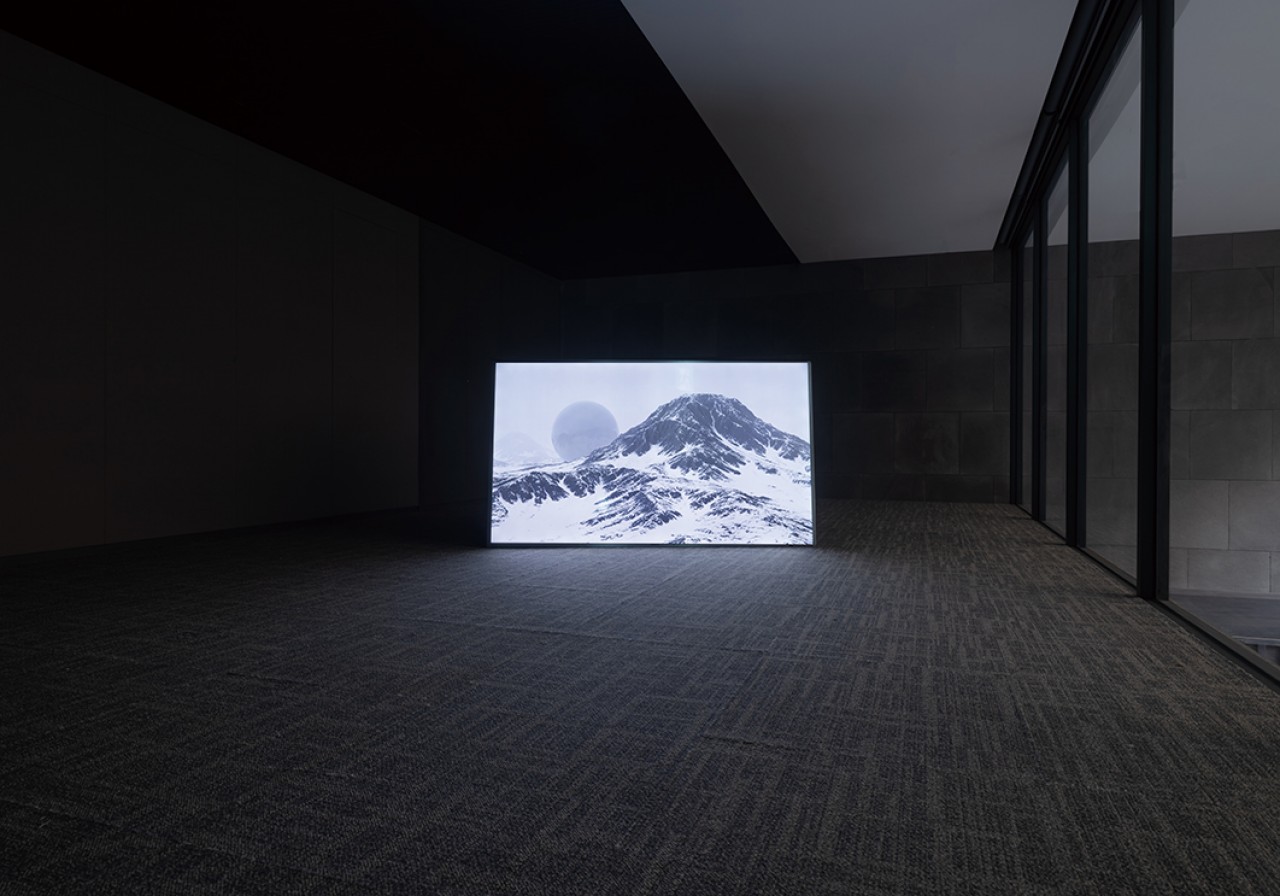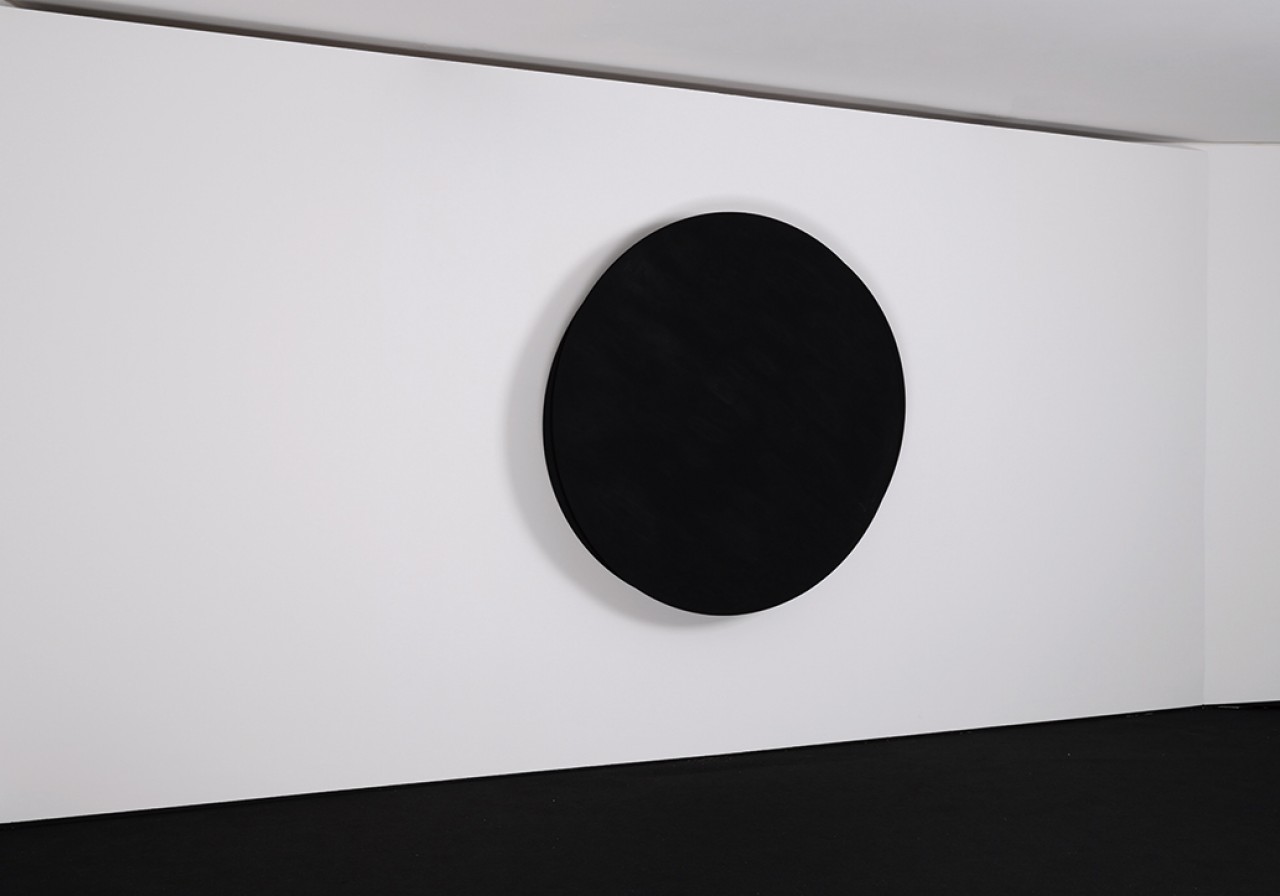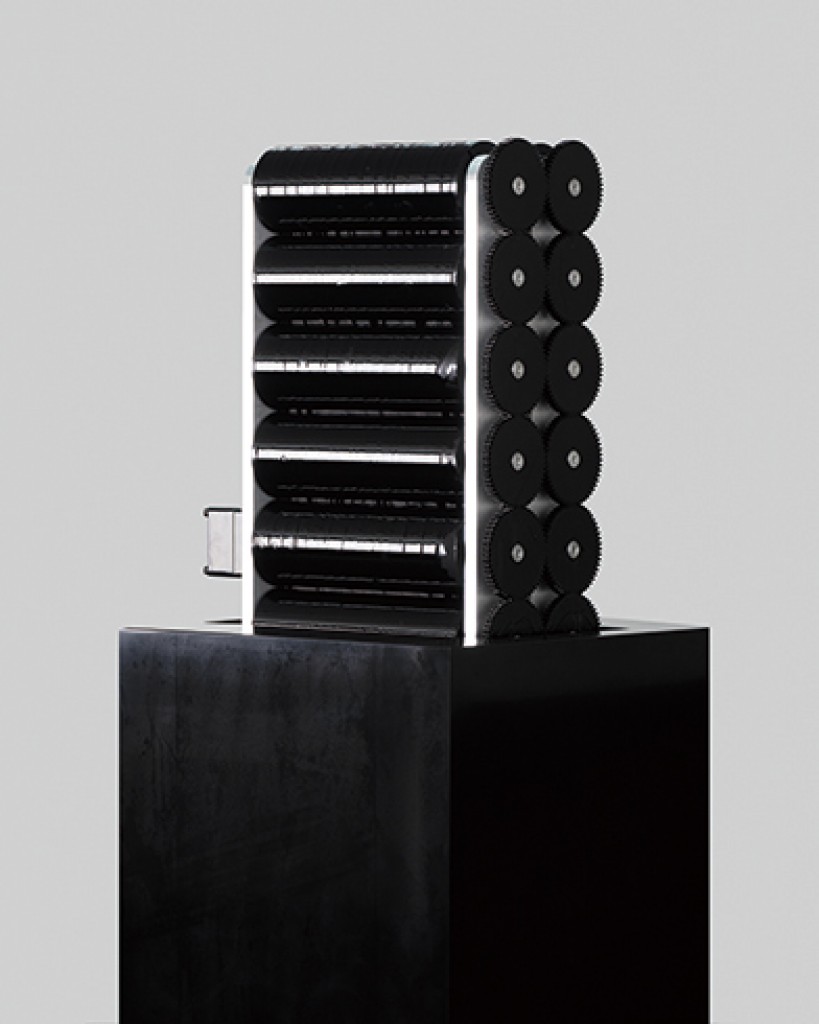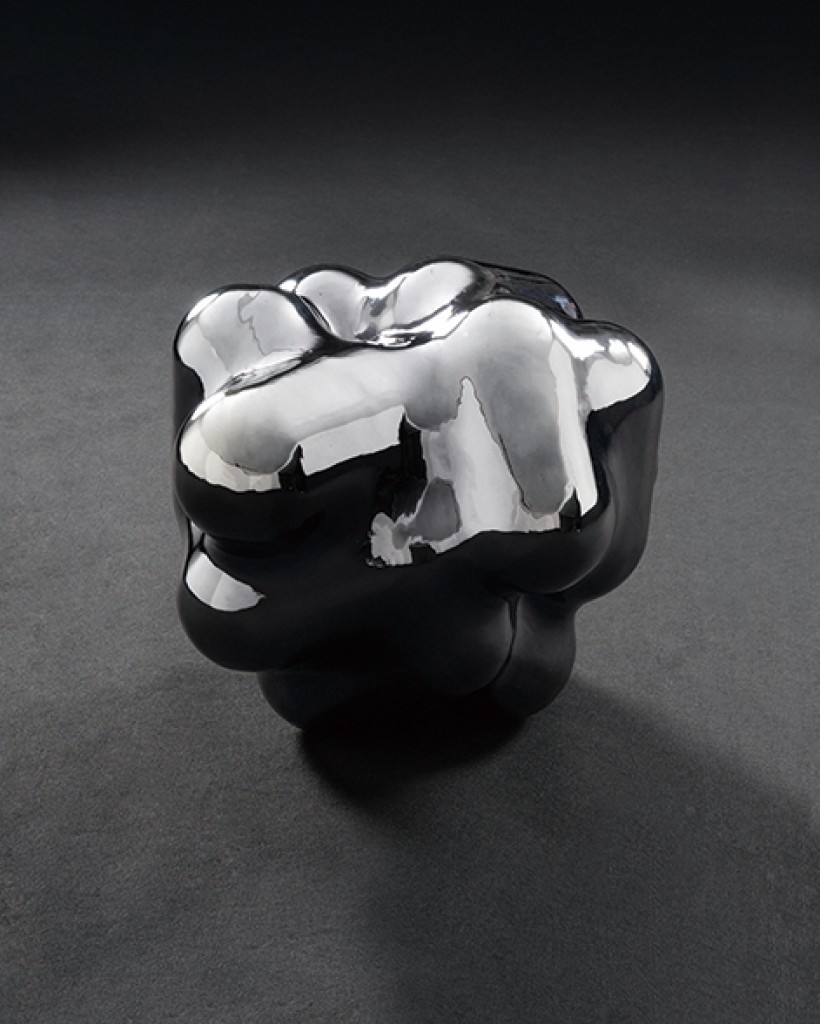Exhibitions
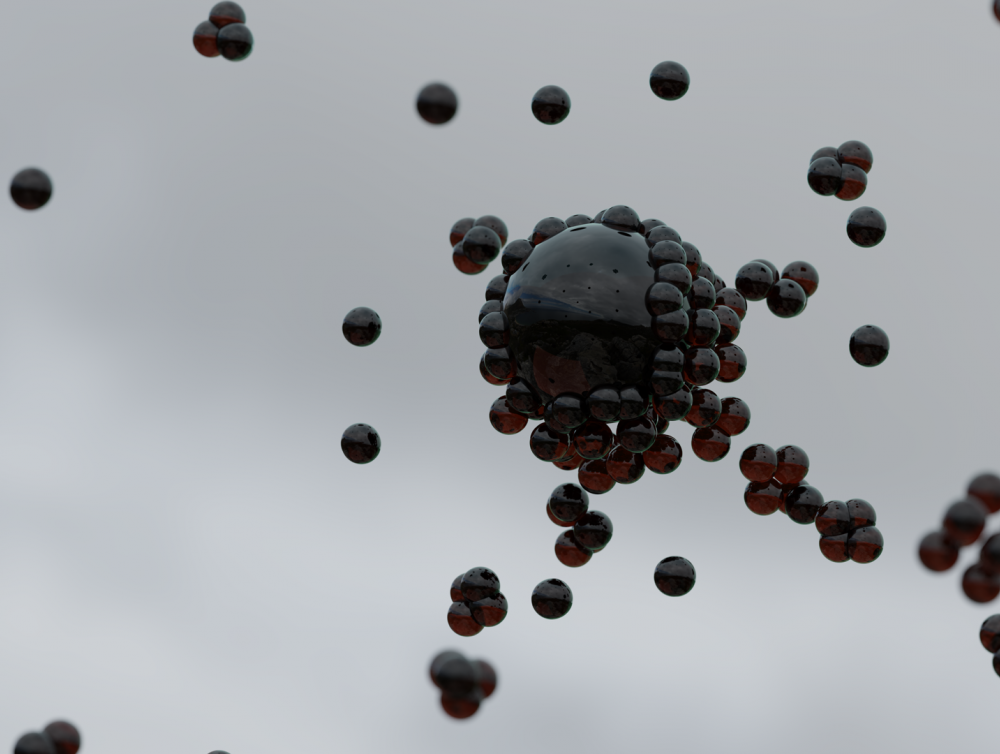
PERIGEE ARTIST #25 정성윤
포도의 맛
2021.06.10. THU ~
2021.08.07. SAT
<우리가 사는 세계라는 기계>
신승오 (페리지갤러리 디렉터)
정성윤은 우리 눈에 드러나지 않는 기계 내부 장치의 프로세스에 관심을 가지고 있다. 이는 단순히 구동 방식에 머물지 않고 기계의 표면과 그 내부 장치 사이의 상호 관계에 대한 것이다. 그리고 이것은 작품을 바라보는 관객과 연결되는 방식을 포함한다. 따라서 그의 작품은 기계의 물성을 가진 유형적인 것과 이를 바라보는 관객의 마음처럼 무형적인 것이 상호 작용하면서 나오는 결과물로 볼 수 있다. 여기서 작가가 주목하는 기계의 표면은 자신이 고안한 장치가 만들어 내는 결과물이 통제되지 못하고 비정형적인 형태로 일시적으로 나타났다 사라지는 것이다. 그렇기에 그의 작품은 우리가 인식하는 경직된 기계에 유연함을 부여하는 조각적 퍼포먼스로 보인다. 이러한 그의 작업은 순차적인 변화를 보여준다. 초기에는 기계 장치의 움직임에 의해 고정되지 않는 형태를 연구하였다. 예를 들면 <Eclipse>는 기계에 연결된 두 개의 원이 반복해서 스칠 듯이 교차하여 잠시 하나가 되었다 분리되는 모습을 보여주거나 <Shapes>에서는 사각형과 삼각형의 외부 경계가 미세한 움직임을 발생시키는 진동으로 인해 잔상이 나타나게 하였다. 그 이후의 작업에서는 재료가 가진 표면의 특성과 통제되지 않는 불확정적인 효과에 대한 관심으로 전이되었다. <우리가 가지고 온 것들>은 탄성 있는 실리콘 줄이 회전과 역회전을 반....
Machine Called the World We Inhabit
Seung Oh Shin (Director of Perigee Gallery)
Jung Sungyoon is particularly interested in a machine’s internal structure and its processes that are usually barely visible. His concern is not merely about its workings but the direct correlation between its external surface and its internal parts, encompassing a spectator’s way of seeing an artwork. Thus, his works can be seen as deriving from the interaction between the tangible like a machine and the intangible like the mind of a spectator seeing it. The surface of a machine he pays attention to refers to an appearance in which a product made by the device he conceived is not controlled and appears atypical but soon disappears. His work seems to be a sculptural performance that imparts flexibility to a rigid machine. Thus his work demonstrates sequential change. His early work focused especially on forms that are not fixed by any mechanical movement. An example is Eclipse in which two circles connected to a machine become one for a moment but are soon separated from each other while repetitively crossing. Another is Shapes in ....
신승오 (페리지갤러리 디렉터)
정성윤은 우리 눈에 드러나지 않는 기계 내부 장치의 프로세스에 관심을 가지고 있다. 이는 단순히 구동 방식에 머물지 않고 기계의 표면과 그 내부 장치 사이의 상호 관계에 대한 것이다. 그리고 이것은 작품을 바라보는 관객과 연결되는 방식을 포함한다. 따라서 그의 작품은 기계의 물성을 가진 유형적인 것과 이를 바라보는 관객의 마음처럼 무형적인 것이 상호 작용하면서 나오는 결과물로 볼 수 있다. 여기서 작가가 주목하는 기계의 표면은 자신이 고안한 장치가 만들어 내는 결과물이 통제되지 못하고 비정형적인 형태로 일시적으로 나타났다 사라지는 것이다. 그렇기에 그의 작품은 우리가 인식하는 경직된 기계에 유연함을 부여하는 조각적 퍼포먼스로 보인다. 이러한 그의 작업은 순차적인 변화를 보여준다. 초기에는 기계 장치의 움직임에 의해 고정되지 않는 형태를 연구하였다. 예를 들면 <Eclipse>는 기계에 연결된 두 개의 원이 반복해서 스칠 듯이 교차하여 잠시 하나가 되었다 분리되는 모습을 보여주거나 <Shapes>에서는 사각형과 삼각형의 외부 경계가 미세한 움직임을 발생시키는 진동으로 인해 잔상이 나타나게 하였다. 그 이후의 작업에서는 재료가 가진 표면의 특성과 통제되지 않는 불확정적인 효과에 대한 관심으로 전이되었다. <우리가 가지고 온 것들>은 탄성 있는 실리콘 줄이 회전과 역회전을 반복하면서 꼬였다가 풀렸다 하는 모습, <통과되는 밤>에서는 인조 모피가 수직으로 회전하면서 그 촉각적인 표면이 무작위로 변화하는 작업을 보여주었다.
이번 전시의 제목은 《포도의 맛_ a mucous membrane》이며, <두 개의 타원>, <뱀과 물>, <래빗>, 영상 작업인 <아말감> 네 개의 작품으로 구성되어 있다. 전시의 한글 제목인 포도의 맛은 미끈한 포도의 껍질이 가진 질감과 입에 넣고 벗겨냈을 때 과육의 맛, 냄새가 유발하는 감각들을 의미하며, 자신의 작업에 대한 은유이다. 반면 영문 제목은 끈끈하고 투명한 점막이라는 직접적인 의미를 드러낸다. 우선 이번 제목에서 작가가 언급하는 점막의 느낌을 염두에 두고 작품들을 살펴보도록 하자. <두 개의 타원>은 말 그대로 두 개의 타원이 하나의 축을 통해 서로 반대 방향으로 천천히 회전한다. 이 회전으로 인하여 개별의 두 타원은 하나의 완벽한 원에 가까운 모습을 보이지만, 원의 경계를 살펴보면 끊임없는 불규칙한 율동으로 구불거리는 윤곽선을 생산하고 있다. 이렇게 하나의 몸처럼 맞닿아 움직이지만 미묘한 엇갈림을 통해 비정형적이고 불투명한 막을 형성한다. 또한 타원의 표면은 빛을 흡수하는 검은색 도료를 사용하여 회전의 중심부는 그 깊이를 알 수 없는 심연과 같은 공간성을 보여준다. <뱀과 물>은 2열로 쌓아 올린 여섯 단의 롤러가 윤활유로 채워진 높은 좌대 위에 설치되어 있다. 이들은 각자의 면이 기어로 맞물려 장치의 하부의 롤러가 회전함에 따라 모든 움직임이 연결되어 윤활유를 상승시킴과 동시에 하강하게 만들면서 피막을 지속해서 형성하고 유지하게 된다. 각각의 롤러는 단독적인 움직임으로 분리되기도 하지만 결국은 합쳐지는 방식으로 서로의 피막에 영향을 준다. 이런 방식으로 발생하는 막은 무엇의 존재가 또 다른 존재의 점막에 서로 영향을 주고받으면서 발생하는 촉각적 접촉의 상황을 그려낸다. <래빗>은 구의 형태가 하나의 덩어리로 되어 있는 것 같은 모습으로 나타난다. 이는 작가가 임의로 시뮬레이션한 결과를 입체 작업으로 구현한 것이다. 먼저 하나의 구가 자신의 지름만큼 움직이면서 생긴 궤적의 형태로 구를 둘러싼 캡슐 같은 막을 상정한다. 그리고 이렇게 형성된 여러 개의 캡슐로 덮인 구를 하나의 커다란 막으로 덮어씌우는 것인데, 여기서 개별의 막은 자신의 형태 그대로 팽창하는 힘이고, 이 모두를 감싸는 그물과 같은 막은 수축시키는 힘이다. 작가는 내부에서 외부를 향한 팽창하는 개별의 움직임과 외부에서 내부로 향한 수축하는 상반된 힘이 서로 공존하는 지점, 다시 말해 각자의 입장이 임계점에 다다른 극적이면서도 정적인 상황을 고스란히 조형 작업으로 재현하고 있다. 영상 작업인 <아말감>은 그가 다른 입체 작업에서 이야기하고 있는 점액과 막, 그가 이전부터 관심이 있었던 물성과 질감, 형태에 대한 것들이 서로 혼합되는 장면들로 나타난다. 영상에서는 가상을 꿈꾸는 현실 공간과 현실을 꿈꾸는 가상의 공간 속에서 작가가 만들어 낸 원형으로 이루어진 작은 점막 하나가 생성된다. 그리고 이것은 점점 부피가 커져 나가다가 어느 단계에서 분리, 축소되는 움직임의 순환을 보여준다. 이는 작품의 제목인 아말감이 수은의 함량에 따라 액체, 크림, 고체로 존재할 수 있는 비정형적인 금속이라는 점과 유사하다. 이를 통해 현실과 가상을 가로지르는 또 다른 비가시적인 얇은 막을 형성하고자 하였다.
그렇다면 그가 말하는 점막은 무엇일까? 그의 작품은 기계 장치가 드러나기도 하고 숨겨져 있기도 하며, 외양의 모습은 끊임없이 움직여서 변하면서도 고요하다. 이러한 움직임은 기계의 내부와 외부가 연결되어 상호 간에 균형을 중요시하여 나타난다. 물론 기계에 의해 상호작용되는 표면은 작가가 의도한 입력값이 수행되는 조작으로 발생한다. 하지만 작가가 제시하는 기계 장치는 단순히 작가의 의도를 담아서 그 행위의 결과를 보여주는 경직된 수동적인 기계로 보기 힘들다. 왜냐하면, 그는 작가의 의도에서 벗어나 완벽하게 통제하지 못하는 상황에 관심을 가지기 때문이다. 이러한 태도는 작가가 기계 장치를 통해 무엇인가를 재현하는 것이 아니라 아직 나타나지 않은 새로운 잠재적인 무엇인가를 생산하기 위한 행위로 보인다. 그렇기에 작품으로서의 결과물은 물질적인 표현으로 존재하긴 하지만 이는 언제나 가변적이다. 오차 없이 무엇을 수행할 것 같은 기계장치는 반복되는 과정에서 어느 순간 완벽하게 통제되지 않을 때가 생기기도 한다. 이런 의도하지 않는 오류는 계속해서 단차를 만들어내고 이것이 쌓여 나가면 그 유격은 점점 더 벌어져 처음의 생각과는 다른 새로운 것이 되어버리고 만다. 작가는 이런 상황을 오류라고 생각하지 않고 오히려 새로운 가능성으로 연결되는 접속 기제로 생각한다. 이는 어느 순간의 찰나적 정점에 다다르고 다시 하강하는 순환의 시간과 공간 구조를 드러낸다. 그리고 이러한 과정으로 인해 개별의 것이 서로에게 매개되는 상황이 발생한다고 본다. 이것이 그가 말하는 점막이라는 것의 성향이다. 그렇기에 이번 전시에서 개별의 작품은 서로를 자극하면서 수축과 이완을 통해 공명하지만 온전한 하나로 합쳐지지는 않는다.
한편으로 그의 작업에서 나타나는 뚜렷한 경계가 드러나지 않고, 하나로 포착되지 않으며, 동일한 형태를 유지할 수 없는 것을 매개하는 또 다른 요소는 관객이다. 사실 인간도 하나의 기계로 볼 수 있다. 육체적인 기관들은 기능적으로 더 진화하거나 퇴화하기도 하면서 유기적으로 연결되어 있다. 이러한 우리의 몸은 스스로 통제할 수 있기도 하지만 ‘나’의 의지와 상관없이 어떤 작용이 발생한다. 그리고 어떤 정보를 눈앞에 두게 되면 우리의 감각기관과 후천적으로 획득한 지식과 경험으로 습득된 것을 통해 순식간에 대상을 인지해 나간다. 이런 관점으로 본다면 사람도 불변적인 것과 가변적인 것, 의식적인 것과 무의식적인 것이 끊임없이 움직인다. 따라서 작가가 보여주는 기계 장치와 다르지 않다. 이렇게 작가는 작품에서 드러나는 점막이라는 매개체로 접속하는 것이 시각적으로만 머물지 않고 촉각, 후각, 미각에 이르기까지 확장할 수 있다고 생각한다. 그리고 이를 가능하게 해주는 것은 관객과 대상 사이에 일시적으로 존재하는 유동적인 점막의 생성과 이를 통한 접속과 분리이다. 이는 존재하는 기능과 존재하지 않는 기능, 의도와 우연으로 인해 발생하는 변수에 의한 것들이다. 그렇기에 점막은 언제나 규정된 형태 없이 끊임없이 변화하며, 무엇인가를 보호하거나 완충작용을 하고 연결하는 역할을 한다. 이 점막은 어떤 명확한 하나의 장치가 또 다른 장치와 연결되면서 잠시 나타나는 마법적 특성을 가진 것처럼 고정된 실체가 없는 세계의 실존을 드러낸다. 또한 여기에는 수없이 많은 존재와 접속된 하나의 단일한 세계뿐만 아니라 연결되지 않은 여러 층위를 가진 다양한 세계가 포함된다.
정리해보자면 작가가 이야기하는 점막은 내부와 외부 사이에 존재하지만, 그렇다고 완전히 굳어진 견고한 틀은 아니다. 이는 무엇인가를 계속해서 욕망하며 움직이고 있으며, 그렇기에 우리가 어떤 대상의 표면을 인식하는 것은 생성과 소멸, 수축과 팽창, 상승과 하강이 순환하는 구조에서 어느 특정한 순간으로 나타난다. 그리고 점막은 하나의 기계와 ‘나’뿐만이 아니라 나와 관계없는 수많은 대상이 서로 접속과 분리하는 과정을 매개한다. 지금까지 살펴본 그의 작업은 단순히 기계의 움직임을 통한 시각적 효과에 주목하지 않는다. 이전까지의 작업이 어떤 상황을 유발하고 이를 사람들에게 관찰하고 인식하기를 유도하였다면 이번 전시에서 선보이는 작업은 여기에서 한발 더 나아가 사유를 위한 명상적 몰입의 시간을 요구한다. 그리고 점막은 잠재적 성질과 행위를 내포하고 있는 인간을 포함한 모든 유무형의 것이 끊임없이 상호작용하는 시공간을 일시적으로 드러나게 하는 것이다. 이렇게 무엇을 촉진하고 다시 완화하는 움직임은 새로운 것이 창발(創發) 되는 자연스러운 과정이다. 이 모든 것은 내재적이면서 동시에 외재적인 현상으로 나타난다. 그의 말을 빌리자면 이를 가시화하기 위해서는 어떤 상황과 이야기의 단면을 잘라내어 그 횡단면을 드러내야 한다. 하지만 작가가 만들어 낸 시공간에 공감하기 위해서는 우리의 몸과 마음이 내부와 외부를 가로지르며 사유할 수 있는 가벼운 상태가 되어야 가능하다. 따라서 그가 만드는 장치로 인해 나타나는 점막은 수동적인 질료로서 기능하는 것에 머물지 않고 끊임없이 움직이는 유동적인 상태를 촉발하는 능동적인 도구이다. 이는 대상과 우리 사이에 점막을 형성하고 다시 새로운 무엇인가로 변환된다. 이러한 점막을 통한 연결은 우리 세상을 구성하고 있는 모든 것이 수평적이라는 것을 의미한다. 우리가 세상과 관계를 맺는 행위는 특별한 것이지만, 세상에 존재하는 모든 것이 ‘나’라는 주체로 연결되는 것은 아니다. 세상은 ‘나’와는 상관없이 서로 접속하고 분리한다. 그래서 우리 앞에 실재하는 세상이라는 기계는 단일하지 않고 고정되어 있지도 않다. 단지 그 모습을 어떤 순간 일시적으로 드러낼 수 있을 뿐이다. 이렇게 그는 인간과 기계, 마음이라는 관념과 실재하는 몸, 외부와 내부, 통제와 오류 사이의 이율배반적인 아이러니를 횡단하는 자유로움 통해 새로운 세상을 인식하게 만든다. 이를 위해 우리에게 필요한 것은 그의 작품과 같이 굳어져 버린 것을 풀어내고 느슨해진 것을 다시 팽팽하게 만들어 내는 중립적이면서 수평적인 태도이다. 결국, 작가는 특정한 하나의 세계에서 벗어나 넓고 수평적인 시선으로 ‘나’를 포함한 부분으로써 기능하는 모든 다양한 층위의 존재를 인식할 수 있도록 우리를 사유의 시간으로 유도한다. 이를 통해 정성윤은 우리에게 지금이 이러한 인식적 전환을 위해서는 새로운 상상력이 필요한 시기가 도래했음을 보여주고 있다.
Seung Oh Shin (Director of Perigee Gallery)
Jung Sungyoon is particularly interested in a machine’s internal structure and its processes that are usually barely visible. His concern is not merely about its workings but the direct correlation between its external surface and its internal parts, encompassing a spectator’s way of seeing an artwork. Thus, his works can be seen as deriving from the interaction between the tangible like a machine and the intangible like the mind of a spectator seeing it. The surface of a machine he pays attention to refers to an appearance in which a product made by the device he conceived is not controlled and appears atypical but soon disappears. His work seems to be a sculptural performance that imparts flexibility to a rigid machine. Thus his work demonstrates sequential change. His early work focused especially on forms that are not fixed by any mechanical movement. An example is Eclipse in which two circles connected to a machine become one for a moment but are soon separated from each other while repetitively crossing. Another is Shapes in which afterimages appear on an external boundary by vibrations generating movement. His subsequent work showed his interest in the characteristic of a material’s surface and its uncontrolled, indeterminate effect. the things we have brought features elastic silicone-foam cords becoming entangled and disentangled when rotation and reverse rotation take place repeatedly while through the night displays artificial fur whose tactile surface arbitrarily transforms as it rotates vertically.
Titled A mucous membrane, this exhibition features four pieces: Two ellipses, Snakes and water, Rabbit, and a video work Amalgam. The exhibit’s Korean title grape flavor is a metaphor for Jung’s work, referring to the texture of grape skin, grape savor, and sensations aroused by its smell, while its English title A mucous membrane reveals its explicit meaning, a sticky yet pellucid mucous membrane. You are above all advised to view his works, bearing some feeling of mucous membranes the artist mentions in mind. In Two ellipses, two ellipses slowly turn around an axis in opposite direction of each other. The two ellipses look like one single complete circle by this rotation, but some wave-like contours are brought about with incessantly arising irregular rhythmical vibrations on the border of this circle. Moving as one body, an atypical, opaque membrane is created through a subtle disagreement. The central area of this rotation displays an unfathomable abyss-like spatiality by applying black paint that absorbs light to the surfaces of those ellipses. Snakes and water is set on a tall pedestal on which two-rowed, six-tiered rollers are filled with lubricant. As each roller interlocks with gears, the level of lubricant goes up or down when the lower roller rotates, constantly generating and maintaining films. Each roller has an influence on forming each film by being separated or united through their independent movement. The film engendered in this way portrays a situation of tactile contact arising when a mucous membrane influences or is influenced by another. In Rabbit a sphere appears as a lump. This work is a three-dimensional representation of what Jung has simulated arbitrarily. This first of all has capsule-like membranes wrapping a sphere in a trajectory generated when the sphere moves around at a distance of its diameter. The sphere wrapped up with several capsules is also covered with one large membrane. While each individual membrane stands for the power to expand while the membrane wrapping up all like a net refers to the power to contract. This work is a representation of a point where each individual power to expand to the outside from the inside can coexists with the power to contract from the outside to the inside creating a dramatic, static situation in which each position reaches a critical point. His video work Amalgam displays a mixture of mucous membranes and membranes he touched on in other pieces, physical property and texture he was interested in, and form. These elements show the cycles of increasing in volume, separation, and reduction. This is similar to the fact that an amalgam, also the title of this work, is an alloy of mercury with another metal that may be a liquid, a soft paste or a solid, depending upon the proportion of mercury. With this, he intended to create an invisible thin membrane cutting across the boundary between reality and imagination.
If so, what is the mucous membrane he defines? A mechanical device is revealed or concealed in Jung’s works while their appearances restlessly move and are in a state of flux but stay calm. This movement results from laying stress on a mutual balance as the inside of a machine is connected to its outside. Of course, the surface interaction by the machine is generated by an operation of input value intentionally performed by the artist. The mechanical device he presents is hardly seen as a passive machine that simply shows the result of its performance made by the artist’s intent. The artist pays attention to a situation that is off the point of his intention and not completely controlled. This attitude seems to be an action not to represent something through the mechanical equipment but to produce something new. That’s why a result as an artwork exists physically but is always variable. The mechanical equipment that is likely to perform something without any errors is at times not completely regulated at some point. Some gap is engendered by this unintended error and this gap widens as it is repeated and becomes something completely different from what is initially intended. The artist regards this error as a connecting mechanism for a new possibility. His result unveils a temporal and spatial structure of the cycle that reaches its peak at some moment and descends again. And he considers that this process causes a situation in which individual elements are intermediated with one another. This is the disposition of mucous membranes he mentions. Although each work stimulates and echoes one another through contraction and relaxation in this exhibition, they are not integrated as one complete thing.
Another element that serves as a medium for what has no apparent boundaries, cannot be captured as one, and cannot maintain the same form is the spectator. A human being can be seen as a machine. Physical organs are organically associated with one another while evolving or atrophying functionally. Our bodies are able to control themselves but some action occurs, regardless of our will. And we come to perceive an object through our sensory organs and acquired knowledge and experience. From this point of view, people are constantly influenced by both the variable and invariable as well as the conscious and unconscious. In this sense, a human being is not so different from a mechanical device the artist presents. He thinks that a connection through a medium of mucous membranes may be extended not only to the realm of sight but also to touch, smell, and taste. What makes it possible is the creation of fluid mucous membranes temporarily existing between the viewer and object and any connection and separation by them. This is what is by existent or inexistent function and by purpose or chance. Thus, a mucous membrane plays a buffering, bridging role in flux without any already fixed or defined form. This mucous membrane unmasks an insubstantial world with a magical characteristic as some apparent device is linked to another. This encompasses one single world connected to innumerable beings as well as diverse worlds with many layers.
To sum it up, the mucous membrane Jung articulates is somewhere between the inside and outside but it is not a completely solid frame. It continuously desires something and is in motion. So our perception of the surface of some object comes up at a specific moment in the structure of the cycles of creation and extinction, contraction and expansion, and ascending and descending. And, his mucous membrane serves as a medium in the process of connecting and separating one single machine and ‘me’ as well as innumerable objects unrelated to me. His work we have thus far reviewed does not take note of any visual effect simply deriving from the movement of a machine. While his previous works aroused some situation and led viewers to obverse and perceive it, pieces on display at this exhibition demand meditative immersion for thinking. And the mucous membrane is to temporarily reveal space-time in which all visible and invisible things including humans interact constantly. The movement of accelerating and alleviating something is a natural process of creatively arousing something new. All these appear as an internal and simultaneously external phenomenon. To borrow his words, we have to unmask the cross sections of some situation or some narrative to visualize this. All the same, our bodies and minds have to become lighten so as to have appreciation of space-time he has rendered. A mucous membrane brought up by the device he made functions not only as a passive material but also an active device to give rise to an incessantly moving fluid state. This is converted into something new, shaping a mucous membrane between objects and us. A connection through this mucous membrane means that everything that constitutes this world is horizontal. Even though an action to make a connection with the world is special, not everything in this world is linked to the subject of ‘me’. Those in this world are connected and separated from one another, irrespective of ‘me’. The machine called the world that exists in reality is neither single nor fixed. It just temporarily reveals its existence at some point. In this way, he makes us perceive a new world through unrestrictedness that cuts across antinomic ironies between man and machine, ideal mind and real body, interior and exterior, and control and mistake. What we need for this is a neutral, horizontal attitude to loosen up something stiff and to tighten something loose. After all, the artist ushers us into a time of thinking in order for us to depart from one specific world and perceive beings in various layers, seeing them from a broad, horizontal point of view. Jung Sungyoon shows we need new imagination for such a perceptual shift and transition.



